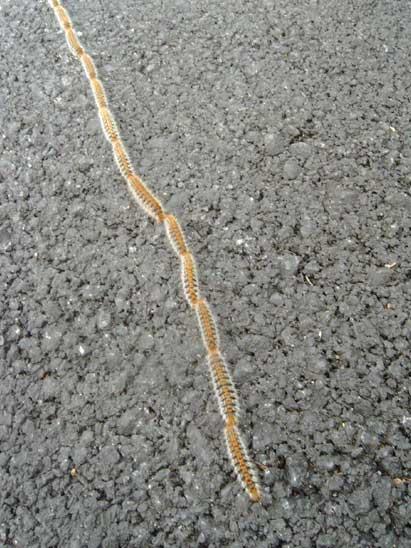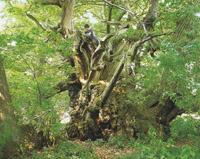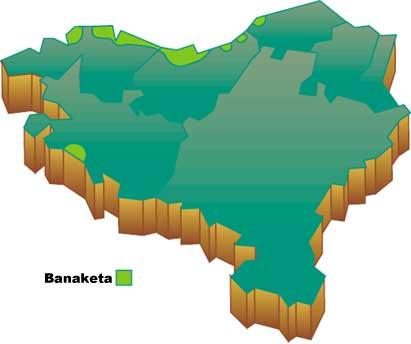Subcutaneous visitor of pine
2007/09/01 Roa Zubia, Guillermo - Elhuyar Zientzia Iturria: Elhuyar aldizkaria
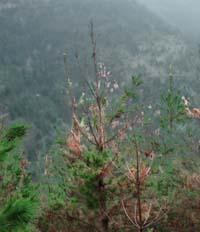
Until a few years ago, experts have stated that the main pest of the pine insignis (Pinus radiata) was the pine shaking (Thaumetopoea pityocampa), since the caterpillars of this species prevent the leaf of the tree. Now, another disease has gained strength and has generated as much concern in the sector as the pine tremor. It is the infection of the fungus Fusarium circinatum.
The infection can be considered an almost specific disease of pine insignis in the Basque Country, that is, it does not affect other species as much. It is documented that it also infects other conifers, most of the pines. If they are inoculated in laboratories it infects fungi, but in the Basque forests only develops in the pines insignis. Although in the world there are other species of pine infected, the infection of the fungus Fusarium circinatum has largely the same geographical distribution as the pine insignis. This means that it is a very general problem.
The pine insignis, native to Mexico and California, has adapted very well elsewhere and has had a great success as a fast-growing tree. But, along with the tree, man has spread the plagues of the tree. Fusarium circinatum has not been an exception.
It was first detected in the California area about twenty years ago. Its pines are very rich from a genetic point of view. Therefore, it is customary for the seed to be transported from there to other parts of the world. And along that road, the fungus also spread. Little by little infected pines appeared, both in nurseries and in the mountains.
Resinous Chancro
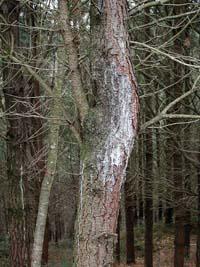
The disease is clearly characterized, since the dry fungus, on the one hand, the top tip of the pine and its branches, and on the other, produces large spills of resin on the trunk, the chancros. They are like wounds on the tree trunk. From them comes the name of the disease: resinous chancro. In general it is not a deadly disease, although in extreme cases the whole tree can dry up. But normally only dry the top of the tree and the tips of the branches.
It is not the only disease with these symptoms. The infection of the fungus Sphaeropsis sapinea also has similar effects: it dries the tips of the horns, causing resin leaks, etc. Therefore, once a damaged pine is located, the sample is taken and the lab is taken to know the fungus that causes the infection. However, today experts perfectly distinguish resinous chancre as closely follow extent of disease.
On the one hand, the fungus is transmitted in pine seeds. Pine does not grow naturally in the forest; man sows seeds in nurseries and, when small pines grow, plants them on the mountain. Therefore, the detection and cleaning of seed infection is a work of the seminar. If infected pines are not cleaned and born, the fungus is easily transmitted from one small pine to another in nursery conditions.
On the other hand, the fungus is also transmitted on the mountain. Often the spores of the fungus are scattered by the wind from one tree to another. Insects can also participate, some xylophagous coleoptera, that is, those who eat wood, which can extend the fungus to the pine forest. And it is possible that man also does it through pruning.
In one way or another, when the fungus extends over the pine forest, dry horn tips appear in it and here, a symptom that for forest guards becomes an alarm.
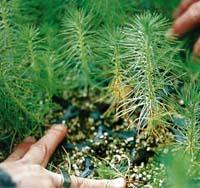
Subcutaneous lacquer
Despite the external vision, the fungus spreads inside. It inhabits under the surface of the pine, in the unhardened part of the wood, that is, in the most active part, since it feeds on the components of that part. In short, it feeds on the softer tissues of the trunk.
Therefore, the disease mainly affects two age bands: when it is very small, the whole plant is made of soft tissues and is old to give flowers (from six / seven years). In the intermediate period it is difficult to develop the disease--the plant is not very small, but has not yet reached sexual maturity, has not given flowers. The soft tissue it has at that time is the most recent outbreak of the year and, in general, the fungus does not affect it. However, when it begins to give flowers, the tree creates new soft structures that are vulnerable.
Infected seeds can be disinfected by heat treatment; if placed at a temperature of 56 ° C in 12 hours, the fungus dies and not the seed, although it loses the germination capacity. Currently the seeds are treated systematically, adding a fungicide to the process. In addition to the seed, it is verified that the substratum with which the seed is sown has no conditions.
The case of sick mountain pines is more serious, since the disease does not have an easy treatment. It is not used fungicide, on the one hand because of the ecological damage they cause in the environment, and on the other, because of the difficulty of penetrating under the surface of the pine. Therefore, the only treatment is the elimination of the sick tree. In turn, they adopt drastic measures: the tree is taken to the sawmill or the trash, and above all the surrounding area is quarantined, a kilometer back. Pine planting is not allowed for two years.
Mushroom Journey
The most concerned plants were the small ones when the disease appeared. In fact, the fungus Fusarium circinatum was detected in nurseries, in seed series from California. It also spread to other parts of the world: Japan, South Africa, Chile, Italy, Iraq, other places in the United States and Mexico, etc.
It also spread throughout the Iberian Peninsula, along the entire Cantabrian coast, from Galicia to Gipuzkoa, as well as to Navarre. At first they thought it was a seminary problem. But they were wrong. Cases were soon found in pine forests.
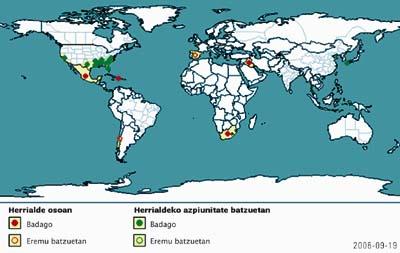
Fraisoro Forest Health laboratories conducted general surveys in 2001 and 2004. In both cases a disease was detected, but in those three years it did not spread. And since then the disease is totally controlled, experts know where it is, and every time an outbreak occurs, they detect and treat it quickly. Today, prospecting is an ongoing activity.
Currently the law obliges the annual monitoring of the fungus. In Gipuzkoa, according to data from 2006, the disease is found in three areas. The first is located on the grounds of Aia, Orio and Usurbil, the second in Hernani and the third in Oiartzun and Irun. Isolated outbreaks have appeared in the south of the province that have been treated and eliminated. According to data from November 2006, the infection is limited to 300 hectares.
Regulations
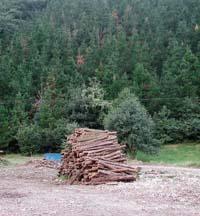
In the Autonomous Community of the Basque Country, the Provincial Councils are responsible for conducting the surveys and the Basque Government itself must officially report the location of the disease. The situation will be communicated annually to the Ministry of Agriculture, Fisheries and Food.
The measures against the disease were regulated by the Ministry itself: treatment of the affected area, collection and transport of wood from these trees, communication of the disease, etc. In Spain, a royal decree was established in 2005, which was completed in Gipuzkoa and Bizkaia in 2006.
The fight against the fungus Fusarium circinatum is valid both biologically and legally. In the reports of fifteen years ago the infection was not known, but today it is a well-known and controlled disease. From now on you will not miss the list of possible diseases of pine insignis.
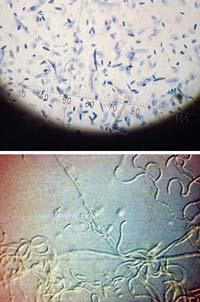
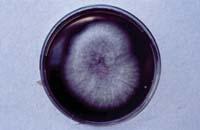

Gai honi buruzko eduki gehiago
Elhuyarrek garatutako teknologia




